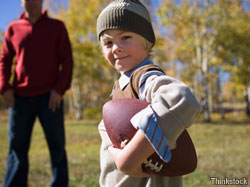
(ARA) – Fall means back-to-school, cooler weather – and an increase in asthma attacks. In fact, childhood asthma statistics show that children with asthma are nearly twice as likely to visit the emergency department when school starts as at other times of the year. That’s largely because autumn allergens and viral infections can unleash childhood asthma symptoms.
A chronic inflammation of the lung airways that causes difficulty in breathing, asthma affects more than 23 million Americans, including 7 million children. It is the most common chronic illness in childhood, leading to 12.8 million missed school days each year. And most people don’t outgrow asthma – it accounts for 10.1 million lost work days.
“Many people end up in the emergency room because they are unaware they or their children suffer from asthma, or they know they have asthma but don’t have it under control,” says Dr. James Sublett, an allergist and chairman of the American College of Allergy, Asthma and Immunology’s (ACAAI) public relations committee. “Asthma can be life-threatening, and although it’s not curable, there are a number of asthma treatment options.”
Suspect you or your child might have asthma? The ACAAI suggests the following tips for breathing easy this fall:
* Get tested, get help – Allergists are specially trained to diagnose and treat asthma. In fact, research shows that asthma sufferers referred to an allergist experienced 76 percent fewer emergency room visits than those not treated by an asthma specialist. Visit www.AllergyandAsthmaRelief.org to take an asthma relief self-test, read about patients who have their asthma under control and find an allergist near you.
* Get treatment -You can treat asthma in a number of ways, including medication that may be taken daily for long-term control and inhalers that can be used to give quick relief when symptoms flare. Often, allergies trigger asthma. To help keep allergies in check, immunotherapy, also called allergy shots, may help. An allergist can help you determine what you’re allergic to and suggest treatments.
* Avoid sniffling, sneezing and wheezing – Kids share lockers, desks – and germs. Viral respiratory infections are widespread this time of year and are the leading cause of severe asthma attacks. If you or your child suffers from asthma, do everything you can to avoid colds and other illnesses, including washing your hands frequently and getting a flu shot.
* Prepare before working up a sweat – Whether during a game of tag at recess, a sprint down the sidelines in a soccer game or a fall fun run, exercise can trigger asthma symptoms. Be prepared with a quick relief inhaler.
* Beware the weather – Fall is known for fluctuating weather conditions. Changes, such as cold, extreme dryness, wetness or wind, can trigger or worsen asthma.
* Look out for new triggers – The start of the school year brings exposure to potential new asthma triggers. Chalk dust, moldy carpeting and the class pet hamster all can be triggers for an asthmatic child. Millions also suffer from hay fever caused by ragweed which is blooming and blowing around in the fall. If your child has asthma, tell the teacher what symptoms to look for and discuss what to do. Your allergist can help you develop an asthma action plan to share with teachers and coaches to make sure your child is safe.
To learn more about how to protect your child from allergies and asthma, or to find an allergist visit www.allergyandasthmarelief.org.





